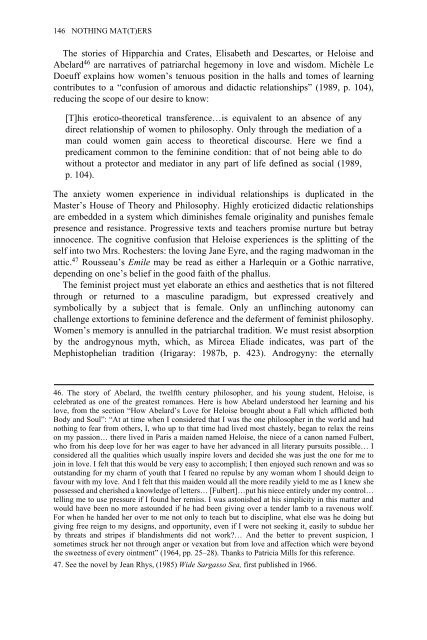Nothing Mat(t)ers: A Feminist Critique of Postmodernism
Nothing Mat(t)ers: A Feminist Critique of Postmodernism
Nothing Mat(t)ers: A Feminist Critique of Postmodernism
Create successful ePaper yourself
Turn your PDF publications into a flip-book with our unique Google optimized e-Paper software.
146 NOTHING MAT(T)ERS<br />
The stories <strong>of</strong> Hipparchia and Crates, Elisabeth and Descartes, or Heloise and<br />
Abelard 46 are narratives <strong>of</strong> patriarchal hegemony in love and wisdom. Michèle Le<br />
Doeuff explains how women’s tenuous position in the halls and tomes <strong>of</strong> learning<br />
contributes to a “confusion <strong>of</strong> amorous and didactic relationships” (1989, p. 104),<br />
reducing the scope <strong>of</strong> our desire to know:<br />
[T]his erotico-theoretical transference…is equivalent to an absence <strong>of</strong> any<br />
direct relationship <strong>of</strong> women to philosophy. Only through the mediation <strong>of</strong> a<br />
man could women gain access to theoretical discourse. Here we find a<br />
predicament common to the feminine condition: that <strong>of</strong> not being able to do<br />
without a protector and mediator in any part <strong>of</strong> life defined as social (1989,<br />
p. 104).<br />
The anxiety women experience in individual relationships is duplicated in the<br />
Master’s House <strong>of</strong> Theory and Philosophy. Highly eroticized didactic relationships<br />
are embedded in a system which diminishes female originality and punishes female<br />
presence and resistance. Progressive texts and teach<strong>ers</strong> promise nurture but betray<br />
innocence. The cognitive confusion that Heloise experiences is the splitting <strong>of</strong> the<br />
self into two Mrs. Rochest<strong>ers</strong>: the loving Jane Eyre, and the raging madwoman in the<br />
attic. 47 Rousseau’s Emile may be read as either a Harlequin or a Gothic narrative,<br />
depending on one’s belief in the good faith <strong>of</strong> the phallus.<br />
The feminist project must yet elaborate an ethics and aesthetics that is not filtered<br />
through or returned to a masculine paradigm, but expressed creatively and<br />
symbolically by a subject that is female. Only an unflinching autonomy can<br />
challenge extortions to feminine deference and the deferment <strong>of</strong> feminist philosophy.<br />
Women’s memory is annulled in the patriarchal tradition. We must resist absorption<br />
by the androgynous myth, which, as Mircea Eliade indicates, was part <strong>of</strong> the<br />
Mephistophelian tradition (Irigaray: 1987b, p. 423). Androgyny: the eternally<br />
46. The story <strong>of</strong> Abelard, the twelfth century philosopher, and his young student, Heloise, is<br />
celebrated as one <strong>of</strong> the greatest romances. Here is how Abelard und<strong>ers</strong>tood her learning and his<br />
love, from the section “How Abelard’s Love for Heloise brought about a Fall which afflicted both<br />
Body and Soul”: “At at time when I considered that I was the one philosopher in the world and had<br />
nothing to fear from oth<strong>ers</strong>, I, who up to that time had lived most chastely, began to relax the reins<br />
on my passion… there lived in Paris a maiden named Heloise, the niece <strong>of</strong> a canon named Fulbert,<br />
who from his deep love for her was eager to have her advanced in all literary pursuits possible… I<br />
considered all the qualities which usually inspire lov<strong>ers</strong> and decided she was just the one for me to<br />
join in love. I felt that this would be very easy to accomplish; I then enjoyed such renown and was so<br />
outstanding for my charm <strong>of</strong> youth that I feared no repulse by any woman whom I should deign to<br />
favour with my love. And I felt that this maiden would all the more readily yield to me as I knew she<br />
possessed and cherished a knowledge <strong>of</strong> lett<strong>ers</strong>… [Fulbert]…put his niece entirely under my control…<br />
telling me to use pressure if I found her remiss. I was astonished at his simplicity in this matter and<br />
would have been no more astounded if he had been giving over a tender lamb to a ravenous wolf.<br />
For when he handed her over to me not only to teach but to discipline, what else was he doing but<br />
giving free reign to my designs, and opportunity, even if I were not seeking it, easily to subdue her<br />
by threats and stripes if blandishments did not work… And the better to prevent suspicion, I<br />
sometimes struck her not through anger or vexation but from love and affection which were beyond<br />
the sweetness <strong>of</strong> every ointment” (1964, pp. 25–28). Thanks to Patricia Mills for this reference.<br />
47. See the novel by Jean Rhys, (1985) Wide Sargasso Sea, first published in 1966.

















